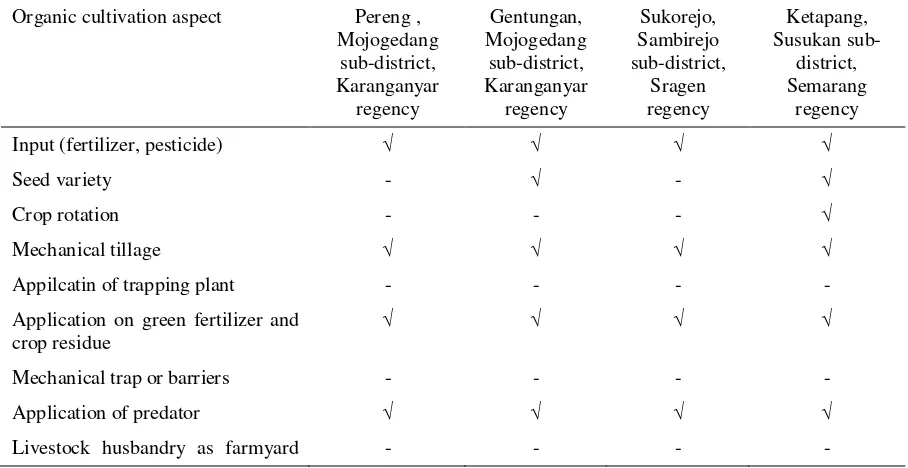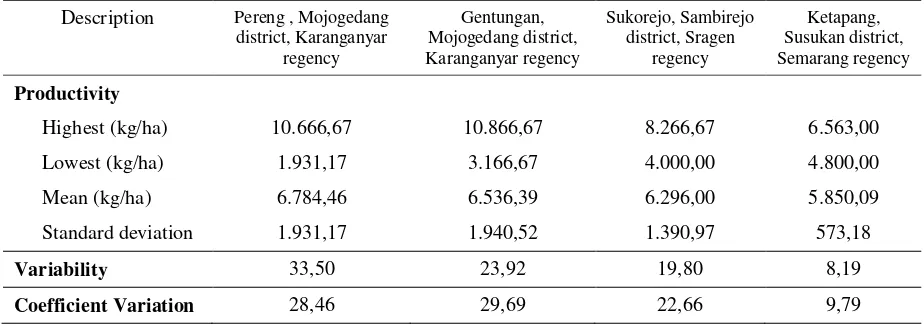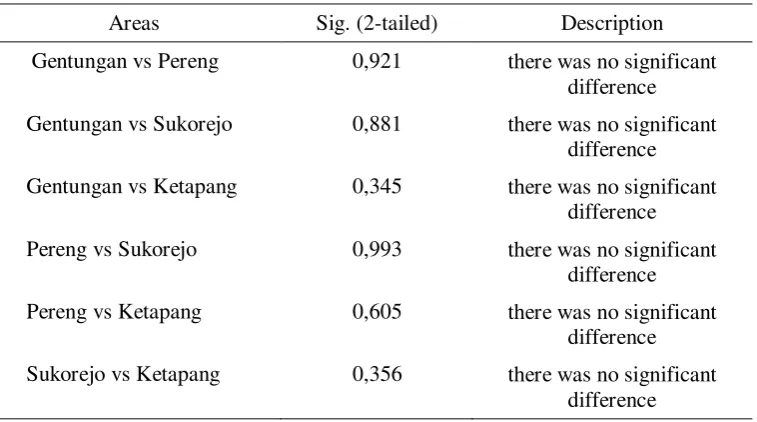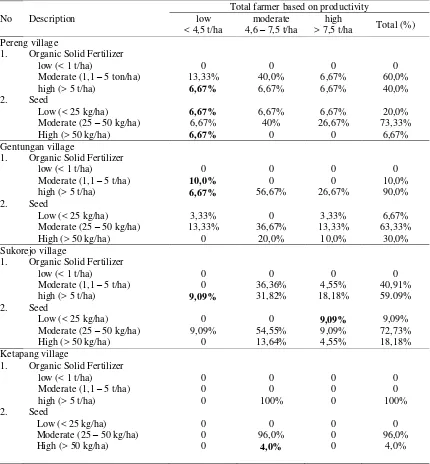Diversity of Organic Rice Farming Productivity
Tinjung Mary Prihtanti1 and Maria1
Department of Agribusiness, Agricultural and Business Faculty Satya Wacana Christian University
Diponegoro 52-60, Salatiga 50711, Central Java, Indonesia *Correspondence Author, e-mail: tinjung.murjono@gmail.com
ABSTRACT
Concurrent with the demand of preserving the environment in farming practices (GAP), organic farming systems had started to develop in Indonesia; one of which is for organic rice production. The province of Central Java is relatively responsive to the movement of organic rice production. This article aims to elaborate the prevailing organic rice production and productivity potential in four regions. Data were collected using survey techniques from farmers practicing chemical-free organic system in growing paddy rice and through literature study. Total respondents interviewed in Pereng village of Mojogedang sub-district in Karanganyar regency and Sukorejo village of Sambirejo sub-sub-district in Sragen regency were determined using census technique. Respondents interviewed in Gentungan village of Mojogedang district in Karanganyar and Ketapang village of Susukan sub-district in Semarang were selected using quota techniques. Data were analyzed using descriptive statistics. Three indicators calculated are productivity, variability of productivity, coefficient of variation between regions. The current practices of organic rice production in those sites had not yet complied with the SNI especially pertaining crop rotation, variety selection, and livestock husbandry as farmyard manure producers. The actual productivity, variability, and coefficients of variation of different farms varied, due to the different agronomic and non-agronomic aspects. The highest organic rice productivity was achievedby farms in Pereng village. This study concluded that the average productivity achieved by organic systems had not been able to reach 7 ton/ha and increment in number of production factors did not always result in higher productivity.
Keywords: organic, rice farming, productivity, coefficient of variation
BACKGROUND
Table 1. Harvested Area, Production and Productivity of Rice in Java and outside Java
Source: Strategic Plan of the Ministry of Agriculture in 2015-2019
Description: (2014 Data of ASEM), the production quality is dry unhusked rice (GKG)
Rice farmng is facing the problem of heavy applications of chemicals input. Rice farming already promoting dependence on agricultural chemicals, both synthetic fertilizers and pesticides, thus ignoring the negative effects on health and environment. The excessive use of agro-chemicals fertilizers has led to a decline of soil quality and productivity (Las, et al, 2006). Thus it leads the "land hunger" where the land actually require more chemicals. Consequently, to maintain the productivity, farmers had to rely on agro-chemical inputs. Though often a phenomenon the fertiizer was rare and difficult to obtain by farmers. In addition, most chemical fertlisers, pesticides, etc are not the domestic reliance but are imported inputs. More importantly, the price of modern inputs increases each year, negatively affecting farmers’ income (Tovignan and Nuppenau, 2004). About 24,43% of the total cost in conventional rice farming are chemicals fertliser and synthetic pesticide costs (Supadi, 2006), and it was increases each year, until about 29,19% recently (Prihtanti et al, 2014).
The Food and Agricultural Organization of the United Nation (FAO) uses Good Agricultural Practices as a collection of priciples to apply for on-farm production and post-production processes, resulting in safe and healthy food and non-food agricultural products, while taking into account economical, social, and environmental sustainability. It encourages any agricultural business had to pay attention to environmental preservation and imposed to meet the production standards that was specified in the international market. According to Brown in (MacKerron et al, 2015) "Demand for organic produce is strong and still growing. We are determined that consumers should be Able to buy organic produce if they want to. We must remember that conventional systems Also produce good quality food that is safe to eat in the quantities consumers demand.
Organic farming emerged in Indonesia at some areas, including West Java, East Java and Central Java. The potential development of organic rice found in the southern region of West Java, among others, Tasikmalaya, Ciamis, Cianjur, and Sukabumi. Some areas of organic farming in East Java, among other Ngawi, Bojonegoro, Tulungagung, and Bondowoso in limited areas. In Central Java province, there was a number of orgamic farming farmers, which cultivate organic food crops, medicinal, vegetables, and fruits plants. Organic rice farmers, relatively more than other types of plants. According to data from the Institute for Machine Tools and Quality Test of Agricultural Products Department of Agriculture and Horticulture, Central Java (2015), organic rice cultivation in Karanganyar, Magelang, Boyolali, and Sragen has widely organic cultivation area than other regions.
OBJECTIVE
Accordingly, development of organic rice farming was encourage to examines the organic farming practices and productivity performance in several areas in Central Java province, taaking case of wetland rice farming. Variations in productivity was helping better understanding about the problems faced by farmers and it will lead to increase the productivity of rice with organic systems.
METHODS
The study was using a quantitative approach on some wetland organic rice growing regions namely in Karanganyar, Sragen, and Semarang. Primary data were collected using survey techniques to organic rice farmers, namely rice farming without chemicals inputs; supported by the literature study. Census technique was applied for farmer respondents, in the Pereng village, Mojogedang sub-district, Karanganyar regency; Sukorejo village, Sambirejo sub-district, Sragen regency; and using because there are only a few rice farmers with organic systems, while samples in Gentungan village, Mojogedang sub-district, Karanganyar regency, and Ketapang village, Susukan sub-district, Semarang regency, using quota techniques.
The study areas shown in Figure 1.
Figure 1. The map of wetland organic rice farming areas in Central Java showing the areas of study
Sukorejo Village, Sambirejo district
Ketapang village, Susukan district
Descriptive statistic analysis was applied to summarise the important characteristics of the rice samples by using simple statistic analysis, i.e. frequency, percentage, and mean. Variables in this study were include the measurement of productivity, variability, and coefficient of variation. Productivity calculated by the ratio of production per hectare of land, while the variability of the data shows the dispersion or variation of productivity achieved by farmers in each location. The coefficient of variation shows the difference in risk faced by farmers in each planting site, defined ratio between the standard deviation and the value of average productivity (Salvatore, 1996). The higher the coefficient of variation, the higher the risks faced by farmers. According Hernanto (1991), when the CV value is more than 0.5 or more than 50% means there is a chance farmer will be loss.
RESULTS
Organic Rice Farming Practices
Referring to Indonesia National Standard (SNI), organic production need to pay attention to the raw materials and processes used in the cultivation process. In the standard of organic agriculture as specified in ISO 6729: 2013, which refers to the IFOAM Basic Standards for organic production and processing in 2005, the establishment of a system of organic food organic food production system, include provisions concerning the production, preparation, marketing, and labeling of products. Table 2, shows that organic rice farming practices in the study site. It was observed that organic farming practices at study site had different application on cultivation. The study site was facilitated by rain and mountain water to irrigate the rice cultivation. In Pereng, Gentungan, and Sukorejo, rice cultivate three times planting season in a year, and no crop rotation, but because Ketapang village was lowland areas, irrigation was not always available throughout the year so there is some organic rice farmers who grow rice only 2 times a year. Some farmers in Pereng, Gentungan,, and Sukorejo still planting seeds of the IR-64 and some farmers grows local seeds, among others Mentik wangi and black rice. Some aspects of organic farming that has not been done in the research sites, shown in Table 2. Farmers knowledge and practicality aspect were the barriers to ideal organic rice cultivation.
Table 2. Organic Paddy Farming Practice
Organic cultivation aspect Pereng , Mojogedang
Application on green fertilizer and crop residue
√ √ √ √
Mechanical trap or barriers - - - -
Application of predator √ √ √ √
manure producers
Quality arranged irrigation (rain or spring water that is not contaminated by chemicals material)
- √ - √
Product labeling - √ - √
Several studies concluded that the awareness of organic farming systems should be improved. Piadozo et al (2014) studied showed that Philippines rice farmers have only a low to medium level of awareness on organic activities and markets for organic products. The development of organic agriculture in Cambodia is supported by the agency CEDAC (organic rice association in Takeo Province) supports local farmers on technical knowledge in organic farming and facilitates the marketing of organic rice products from local farmers. However many farmers in the region could not adapt organic rice farming is possibly due to the lack of education on the benefits of organic farming. Karki et al (2011) concluded the need on training and mentoring policy to raise awareness about the benefits of organic farming.
Productivity of Organic Rice Farming
Table 3 shows differences organic farm productivity in four areas of planting. The highest productivity of organic farming was achieved by farmer in Pereng, Mojogedang district, Karanganyar regency ie 6.78 tonnes/ha, and the lowest was achieved by organic rice farmers in Ketapang village, Susukan, Semarang regency.
Table 3. Productivity of Organic Paddy Farming
Description Pereng , Mojogedang district, Karanganyar
regency
Gentungan, Mojogedang district, Karanganyar regency
Sukorejo, Sambirejo district, Sragen
regency
Ketapang, Susukan district, Semarang regency Productivity
Highest (kg/ha) 10.666,67 10.866,67 8.266,67 6.563,00
Lowest (kg/ha) 1.931,17 3.166,67 4.000,00 4.800,00
Mean (kg/ha) 6.784,46 6.536,39 6.296,00 5.850,09
Standard deviation 1.931,17 1.940,52 1.390,97 573,18
Variability 33,50 23,92 19,80 8,19
Coefficient Variation 28,46 29,69 22,66 9,79
Source: primary data
Distribution of farmers according to the achievement of productivity seen in Figure 2. It was observed that organic rice productivity in Ketapang village, Semarang regency, was at a moderate level, while rice productivity performance in other regions varied at a low level and high.
Figure 2. Organic Farming Productivity
Farmia (2008) studied showed the average yield of organic rice from 2003 to 2007 was only 2,9 t/ha. The observations and data analysis showed that although the productivity of organic rice is increasing year by year in these subdistricts, the area of fields under organic cultivation and the yields of organic rice have remained low because of problems arising from farmers, extension workers, markets and local government.
Agronomically, the productivity of rice farming is the resultant of the effects of three factors: physical environmental factors in the location of production activities, production viability of rice varieties are used, and the quality of farming or quality of cultivation (De Datta et al., 1987, Dey and Hossain, 1995 in Irawan, 2004). Rice productivity was different between study site, influenced by differences in site conditions as well as different levels of input and rice varieties are used. Statistically, there was no significant different productivity mean between study site (Table 4).
Table 4. t-test Result of Organic Rice Productivity
Areas Sig. (2-tailed) Description
Gentungan vs Pereng 0,921 there was no significant difference
Gentungan vs Sukorejo 0,881 there was no significant difference
Gentungan vs Ketapang 0,345 there was no significant difference
Pereng vs Sukorejo 0,993 there was no significant difference
Pereng vs Ketapang 0,605 there was no significant difference
Sukorejo vs Ketapang 0,356 there was no significant difference
0 20 40 60 80 100 120
% farmer
Region
The diversity of high productivity occurs in the organic rice cultivation in Pereng, District Mojogedang, Karanganyar. The high achievement diversity of productivity due to the high diversity of use of production inputs. Differences production factors can also affect farm productivity performance. Table 5 shows the differences in the average amount of input application in production, namely fertilizer, seed and labor.
Table 5. Differences in the use of production factors and Production
Description Pereng village, Mojogedang
district, Karanganyar
regency
Gentungan, Mojogedang
district, Karanganyar
regency
Sukorejo, Sambirejo district,
Sragen regency
Ketapang, Susukan
district, Semarang
regency
Organic solid fertilizer (kg/ha)
Highest 17.857,14 10.857,14 12.000,00 8.158,9 Lowest 1.250,00 2.692,00 2.500,00 7.000,00 Average 6.158,63 7.558,65 5.827,68 7.604,50 Standard deviation 5.142,21 1.919,76 2.060,89 362,56
Seed (kg/ha)
Highest 66,67 140,00 100,00 51,00
Lowest 11,90 11,91 20,00 40,00
Average 35,53 46,24 40,01 45,09
Standard deviation 13,61 22,46 24,17 3,36
Labor (HOK/ha)
Highest 248,27 512,00 173,33 1.477,74
Lowest 48,68 100,80 101,05 836,2
Average 156,49 193,79 140,06 1.085,08
Standard deviation 48,68 88,07 24,42 150,09
In Table 5, it is showed that organic rice cultivation in Sukorejo was using lowest amount of solid organic fertilizer than other areas, while farmers in Pereng was using less amount of seeds than three other areas, and farmers Ketapang village paddy highest in the use of labor. According to these result, there was indigenous mechanism in organic rice farming at study site. It is influenced by the physical conditions, social roles, and adaptive skills of local people, usually derived from many years of experience.
Table 6. Number of Farmers Rice based Fertilizer and Seed with Productivity
No Description
Total farmer based on productivity
Seeds provide a major influence in the achievement of productivity. Some research concludes concluded treated varieties of paddy rice shows a significantly different effect on yields (Hermawati (2012), besides according Muyasir (2012), the number of seeds per planting hole significantly affect the results of tile rice crop. Farmers organic rice in the village Pereng, Karanganyar more planting rice variety IR 64, while farmers in the village Gentungan, Karanganyar, Sukorejo, Sragen, were cultivate IR-64, Mentik wangi; and Ketapang village, Semarang regency more plant menthik wangi, pandan wangi, and black rice. Variety menthik wangi is a local seed is actually more ideal as seed of organic rice farming, but productivity levels are relatively low, causing some organic rice farmers in all regions of the study still choose to cultivate IR64 variety. Low number of seed not always gave high productivity, as seen Table 6, as Masdar et al (2006), that the plants growing on the spacing of the meeting can lead to stress on seedling vigor so that development is hampered. Spacing less frequently led to the development of the number of tillers and tillers become more productive as well as the production of rice produced is also higher.
Effect of Institutional Aspect
Institutional aspect is one of the variables that also affect the success of organic rice farming. Disclosed by Wahyu (2003), farmer groups have an important role in the development of farming, in which to improve the performance of farming farmers' groups need to be improved include land tenure members of both groups, the number of group members, and active cooperation by supporting organizations. Mwaura (2014), membership to groups resulted in increased yields for banana and cassava. Group members were less likely to adopt inorganic fertilisers and improved seed than non-groups members.
All organic farmers in the study area are members of a farmers' group. Togetherness in solving the problem of farming could encourage farmers to avoid the failure anf risk of organic rice farming. Among the four sites, organic rice farmer groups in Ketapang had most long experience in organic farming. Organic rice farmers Ketapang village, Semarang regency incorporated in Al-Barokah Growers Association, a group of farmers who cultivate rice organically since 1998. Al-Barokah Farmers Association also has many achievements, both at national and provincial levels associated with the development of organic farming.
CONCLUSION
REFERENCES
Anonim. 2013. ISO 6729: 2013 (http://www.biocert.co.id/)
Farmia, Asih. 2008. Development of Organic Rice Farming in a Rural Area, Bantul Regency, Yogyakarta Special Region Province, Indonesia. Journal of Developments in Sustainable Agriculture 3: 135-148
Giovannucci, Daniele. 2005. Organic Agriculture and Poverty Reduction in Asia. IFAD: Rome,
Hermawati, Tiur. 2012. Growth and Yield Six Lowland Rice Varieties on Tanam.Jurnal Bioplante difference. Vol 1 No. 2 April-June 2012. online-journal.unja.ac.id/index.php/ bioplante/article/download/1811/1192
Hernanto, F 1993. The Farm Science. Swadaya. Jakarta
Karki, Lokendra, Rosa Schleenbecker, Ulrich Hamm. 2011. Factors influencing a conversion to organic farming in Nepalese tea farms. Journal of Agriculture and Rural Development in the Tropics and Substropics. Vol 112 No. 2 (2011) 113-123.
Kennvidy, SA. 2011. Organic Rice Farming Systems in Cambodia: Socio-Economic Impact of Smallholder Systems in Takeo Province.
Las, Irsal, Subagyono, AP Setiyanto. Issues and Environmental Management in Agriculture Revitalization. Agricultural Research and Development Journal Vol 25 No. 3. 2006.
MacKerron, D.K.L, J.M. Duncan, J.R. Hillman, G.R. Mackay, D.J. Robinson, D.L. Trudgill, and R.J. Wheatley. 2015. Organic farming: Science and Belief. http://www.scri.ac.uk/scri/file/annualreports/1999/06ORGFAR.PDF
Masdar, Musliar K., Bujang R., Nurhajati H., dan Helmi. 2006. Tingkat Hasil dan Komponen Hasil Sistem Intensifikasi Padi (SRI) Tanpa Pupuk Organik di Daerah Curah Hujan Tinggi. Jurnal Ilmu Pertanian, Vol 8 (2). 126-131.
Muyasir. 2012. Effect Plant Spacing, Age, and Total Seed on Yield Rice. Land Resources Management Journal, Volume 1, Number 2, December 2012: p. 207-212. www.jurnal.unsyiah.ac.id/MSDL/article/download/2190/2146
Mwaura. F. 2014. Effect of Farmer Group Membership on Agricultural Technology Adoption and Crop Productivity in Uganda. African Crop Science Journal, Vol. 22, Issue Supplement s4, pp. 917 - 927 ISSN 1021-9730/2014 Printed in Uganda. All rights reserved ©2014, African Crop Science Society
Numalina, Rita. 2008. Index Analysis and Sustainability Status System Availability Rice in some Region Indonesia. Agro Ekonomi Journal. Volume 26 No. 1 Mei 2008:47-79.
Prihtani, Tinjung Mary, Suhatmini Hardyastuti, Slamet Hartono, Irham 2014. Social-Cultural Function of Rice Farming Systems. Asian Journal of Agriculture and Rural Development. Vol. 4. No 5-6-7, 2014
Renthiandy, Pratiska Anevi, Joko Sutrisno, Mei Tri Sundari. 2015. Risk Analysis rice farming in Kecamatan Karanganyar Karanganyar. AGRISTA e-journal.Edisi 2 Vol 2 2014
Sari, Rahma Pramita, Titik Islami, and Titin Sumarni. 2014. Fertilizer Application to minimizing Inorganic Fertilizer Production in Rice (Oryza sativa L.), Method of SRI. Journal of Crop Production Vol. 2 No. 4 April 2014: 308-315. http://download.portalgaruda.org/ article.php? article = 191025 & val = 6473
Salvatore, D. 1996. Managerial Economy in a Global Economy. Third edition. The McGraw-Hill Companies. Inc.
Supadi. 2010. Cost Structure and Profitability Food Crop Farming (Case Villages of Patanas). Centre Socio Economic and Policy Bogor. Jurnal Agro Ekonomi. Vol. 30.
Tati Suryati and Sri Aktaviani. 2009. Application of Fertilization On Organic Rice Farming System Method Of Intensification (SRI) In the village Sukarasa Tasikmalaya regency. J. agroland. 16 (1): 1-8.
Tovignan, DS and Nuppenau, EA. 2004. Adoption of Organic Cotton in Benin: does gender play a role? In conference on rural poverty reduction through research for development and transformation. Deutscher Tropentag, 5-7 October 2004. Benin.






